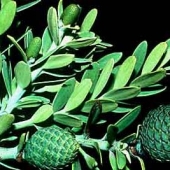Please select root levels for the menu
NZ Plants
Agathis australis - kauri
Family: Araucariaceae
-
Mature foliage
A Turner
View picture -
Juvenile foliage
I MacDonald
View picture -
Branches, older tree
L Jensen
View picture -
Base of intact and shed branch
View picture -
Base of shed branch
L Jensen
View picture -
Mature bark
L Jensen
View picture -
Bark pores (lenticels)
L Jensen
View picture -
Immature pollen cones
L Jensen
View picture -
Mature pollen cone
I MacDonald
View picture -
Mature pollen cone, upturned ends of cone scales have separated allowing pollen to escape
L Jensen
View picture -
Mature pollen cone cross section, two cone scales with attached pollen sacs
L Jensen
View picture -
Ovule cone at pollination
I MacDonald
View picture -
Developing seed
L Jensen
View picture -
Ripe seed cone shedding scales and seeds (left) and seed cone just prior to ripening (right)
L Jensen
View picture -
Shed seed cone scales with winged seeds. One seed is formed per scale.
I MacDonald
View picture
Agathis australis is easily recognized by its massive unbranched columnar trunk with stout branches at the top. Younger trees have whorled branches with thick and leathery, linear-oblong leaves. Seed cones are woody and disintegrate on the tree to release winged seeds.
An endemic species found as isolated groves in the northern half of the North Island.
Agathis is a small genus of about 20 species, all except for one in Borneo, restricted to the Southern Hemisphere.
More on kauri: Takana Newsletter
Vegetative characteristics |
Reproductive characteristics |
|---|---|
Adult plant form: tree up to 60 m tall with widely spreading branches |
Pollen and ovule cones: on the same tree |
Adult leaf form: broadly lance shaped or paddle-shaped with parallel veins |
Pollen cone: 30-50 mm long, 10-14 scales, each with 3-5 sporangia |
Adult leaf size: 20-35 x 8-20 mm |
Ovule cone: spherical, 50-80 mm diam., 100-500 scales |
Adult leaf arrangement: singly on the stem |
Ovule position: one ovule on the upper surface of each cone scale |
Juvenile plant form: narrow, conical tree |
Ovule covering: a single covering (integument) |
Juvenile leaf form: lance-shaped |
Ovule pore: inverted (facing cone axis) |
Juvenile leaf size: 50-100 x 5-12 mm |
Mature seed cone: spherical and woody, 50-170 mm diam. releasing numerous winged seeds |
Juvenile leaf arrangement: spiral but often appearing as if in two rows on flattened shoots |




